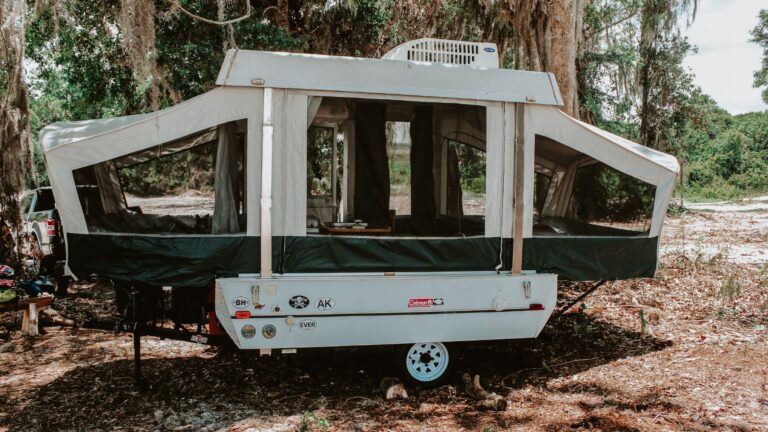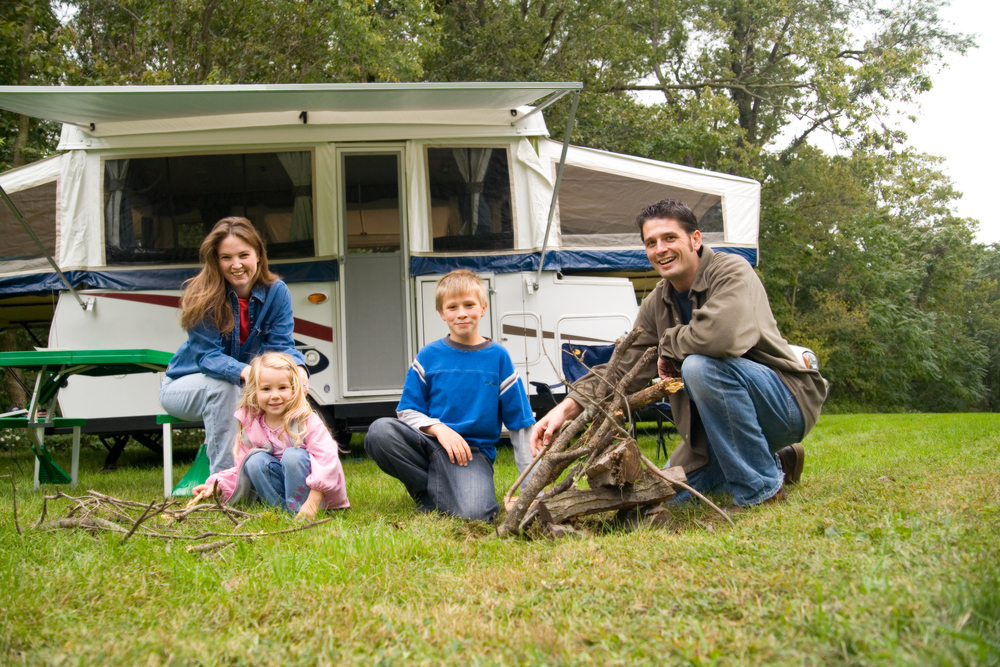
Pop-up campers are a great option for many travelers. They’re convenient – many of them can be towed by almost any vehicle including a car. They’re lightweight so you can take them on many roads that larger trailers or motorhomes can’t handle. They don’t affect your vehicle’s gas mileage to an extreme degree.
If you’re considering a pop-up camper, here’s what you should know about them.
Pop-Up Campers: What You Need to Know
Pop-up campers are much more compact than travel trailers and motorhomes of various classes. However, these trailers can come in a variety of shapes and sizes. There are soft- and hard-sided pop-up campers, as well as A-frame pop-up campers, hard-top pop-up campers, and more.
Is a Tent Trailer the same as a Pop-Up Camper?
Tent trailers, also known as pop-up campers, so although they are two different names they refer to the same style of camper.
Pop-Up Camper Features
Pop-up campers have soft canvas sides that allow for the pop-up and fold-down mechanisms to work. They sometimes have hard tops to support air conditioning units. These tops are also convenient for storing adventure gear like kayaks and bicycles. They’re rugged and outdoorsy while still offering a significant upgrade from sleeping on the ground.
That range of sizes means that pop-up campers can come in a whole range of layouts, and may sleep anywhere from two to eight adults. There are pop-up campers with bathrooms, pop-up campers with a single stove burner and pop-up campers with fully-functional kitchens. One of the best things about this class of RV is how diverse and versatile they are. There are even toy hauler pop-up campers, allowing you to bring along your ATV. There are high-wall pop-up campers, featuring taller boxes for more living and storage space. And because they’re so small and lightweight, many of these pop-ups can be towed behind much smaller vehicles than traditional travel trailers. Some pop-ups can even be towed behind motorcycles!
| Feature | Details |
| Length | Packed: 8-16 feet Popped up: 16-32 feet |
| Weight | 700-3,000 pounds |
| Sleeping Space | 2-8 adults |
| Amenities & Features | Features vary but may include: – Air conditioning – Kitchenettes (stovetops, refrigerators) – On-board plumbing systems & water tanks – Bathrooms – Showers (interior/exterior) – Propane furnaces – Generators |
| Cost | $10,000-$25,000 new |
Pros and Cons of Pop-Up Campers
Pop-up campers are easy to drive. They may be a great option for people who like the comforts of RV camping but are intimidated by the prospect of driving a large motorhome or weighty trailer. Although pop-up campers are towed vehicles and will require some practice, they’re much lighter than other types of travel trailers and can often be towed behind your regular vehicle. That’s a whole lot less of a headache than driving a one-ton truck!
Because of their compact size, pop-up campers are easier to navigate and can get down narrow, dirt roads that might be a challenge for larger recreational vehicles. If you’re in the market for some serious off-grid adventuring, pop-up campers are an excellent way to get out there.
Pop-up campers are relatively inexpensive for the RV world, so they can be an accessible way to take an RV camping adventure without breaking the bank.
Of course, what these little RVs offer in the way of flexibility, affordability, and rugged readiness, they do lack in living space and some of the more premium creature comforts you can find in high-end luxury RVs. If you’re traveling with a large family or lots of adventure gear, you may feel squeezed for space. And if you’re looking for a resort-style, kick-your-feet-up getaway with all the extras, pop-up camping may feel like roughing it.
But if roughing it is what you’re after, these powerful little vehicles can be a great way to get out there and start your adventure.
Pop-Up Camper Manufacturers

When you’re first looking for an RV, the array of brands and manufacturers can feel daunting. Here, we’ll list a few of the most popular manufacturers and makers of new pop-up campers. Many of these brands are also well-known for their motorhomes and full-sized travel trailers as well.
Dutchmen/Coleman
Renowned for its well-built, well-priced range of travel trailers, Dutchmen has been in the RV-making business for decades now — which means they’ve had a lot of time to learn how to make the best trailer possible.
Coleman pop-up campers are a particularly popular model and can be found used through listings on RV Trader and other classifieds. The newest Coleman camper layouts are a little more complex than traditional fold-outs, and they have hard sides, slide-outs, and an array of amenities closer to what you’d expect of a traditional travel trailer.
Jayco
Jayco is another well-known name in RV manufacturing, and they craft a wide range of travel trailers as well as motorhomes. Plus, many of these parts are backed by a 2-year warranty, which is regarded as one of the best in the business.
Starcraft
Specializing specifically in trailers, Starcraft makes pop-up campers as well as traditional travel trailers, toy haulers, and fifth wheels. They pride themselves on making their products lightweight across the board.
Starcraft was actually an industry leader in the world of pop-up campers when it invented the first crank lifter system to help make “popping up” a whole lot easier. That was all the way back in 1964… so the company has some long-standing expertise.
All Terrain Pop-Up Campers
This company’s tagline is “built to survive” — so if you’re looking for a rough and ready pop-up camper, this is a good option. All Terrain specializes in small, expandable camper tops that fit in standard truck beds, making them even more rugged and convenient than some of the other options listed above.
You’ll want to make sure your potential camper will actually fit in your truck bed, however. You can choose from a wide range of features and options when you scroll through the All Terrain Campers website.
You can also check out our more complete listing of RV manufacturers and the different types and styles of travel trailers and motorhomes they produce.
Renting a Pop-Up Camper
Whether you want to experience as many different brands and manufacturers as possible before you make a purchase decision, or you’re simply looking to dip your toe into RVing, the best way to get a real sense of what camping in a pop-up camper is like is to do it! Thanks to peer-to-peer RV rental marketplaces like RVshare, you can try out a variety of campers close to home.
Not only will you have a whole lot more options to choose from, but you’ll also get experience camping in a rig that’s been vacationed in and loved by a real family.
Since pop-up campers are so small and lightweight, chances are you’ll even be able to tow one behind your existing vehicle — but if not, many RVshare owners are willing to tow your rental to the destination and set it up for you for an additional fee.
Tips for Traveling in a Pop-Up Camper
Traveling in a pop-up camper is a different experience than taking to the highway in a Class A motorhome, or even a modestly-sized trailer. If you’re traveling with a large family, or are simply new to the experience of living in such a small space, you may find pop-up trailers a little challenging at first. Here are a few tips.
Stay organized
The ability to travel with more stuff is one of the things that brings people to the RVing world in the first place. But with a pop-up camper, you won’t have the same amount of space you might with a larger RV. Because these little rigs fold down into super-portable boxes, you won’t get tons of extra room to stow your stuff while you’re in transit.
But there is one serious saving grace: your pop-up camper’s hard top. This can be used as a flat surface to store adventure gear like bicycles, kayaks, or skis. You’ll often see pop-ups cruising down the road carting all sorts of goodies to help their drivers go exploring once they reach their destinations.
Once you set up camp, you’ll have access to a bit more storage, like under-bed cabinets and kitchen drawers. Even so, staying organized is important if you want to avoid crowding yourself out with your own stuff! Check out these clever ways to get your camper organized, as well as these space-saving kitchen accessories. We’ve also written about items you should not add to your to-bring list.
Start simple
For your first pop-up camping trip, you may want to keep things simple. Stay at a campsite close to home. Arrive with plenty of daylight left to set everything up while you can still see easily. Don’t plan elaborate meals or activities. Just like any skill, camping gets better with practice! Also, if you choose a place near home and it doesn’t go well, you can always pack it in and try again another time.
Prep meals at home
Your space is limited, and you may want to do any prep work for meals at home. You can even cook entire dishes so that they simply need to be reheated when you are camping. Take any food items that are packaged in large containers and put smaller amounts into smaller packaging to take up less room.
Move things outside
Pop-up campers aren’t very large. Any activities you can move outdoors will give you more room in your camper for sleeping. Set up camp chairs outside your camper. Bring a camp stove or plan to cook over the campfire. Store any large items like paper towels in a waterproof bin outside (but make sure they don’t smell and attract animals!). Try to clear as much room inside your camper as you can.
Consider gas mileage
These light campers aren’t going to affect your gas mileage as much as a large Class A motorhome or a big fifth-wheel trailer. But they may cause your vehicle to get slightly lower gas mileage than when it’s not towing. Some campers report that towing a pop-up trailer causes them to lose about a mile per gallon on their gas mileage when they travel.
Pop-up campers require a little ingenuity to make the most of their small space. But their lightweight construction means they can travel to a lot of exciting out-of-the-way places, and they can be towed by just about any vehicle. They’re a great choice for solo travelers, couples, and smaller families that want more comfortable amenities than tent camping without going into full glamping mode.

